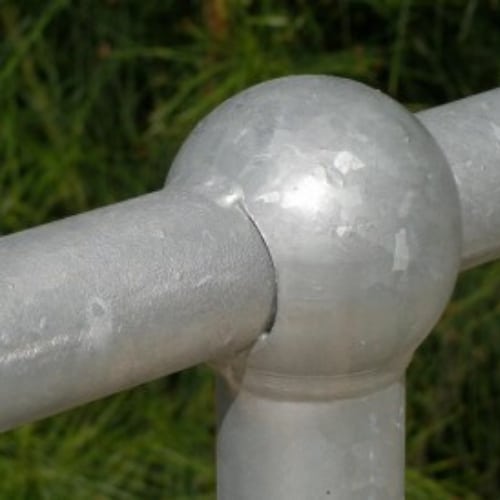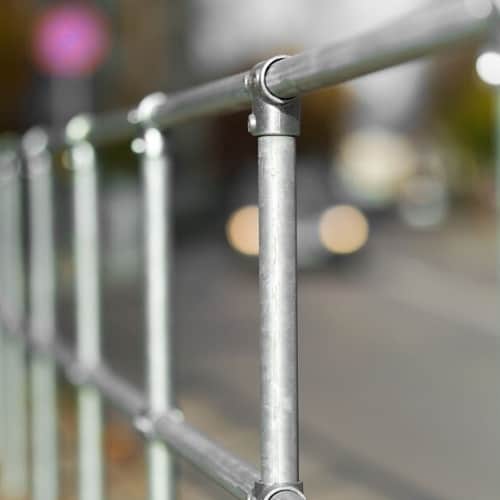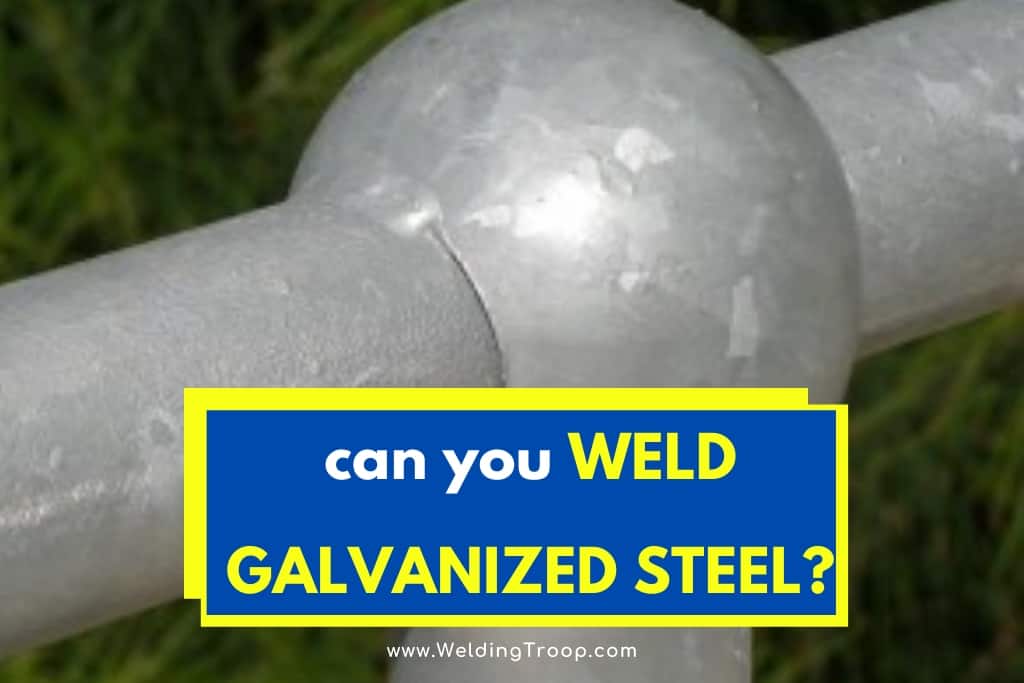So, you’ve worked with different metals in your welding projects, but have you wondered if you can weld galvanized steel? When you weld galvanized steel, it’s crucial to protect yourself and work in a ventilated environment.
Can you weld galvanized steel? You can weld galvanized steel with flux core wire. However, zinc coating produces extremely toxic fumes that must be vented away. Protective gear and proper ventilation are essential to welding galvanized steel safely.
As you know, welding requires a high level of patience and skill. New challenges arise with each new project. One week you may weld copper pipes, and the next week you’re welding steel girders. The unpredictability and sudden problems make welding an exciting craft.

Since metals have different melting points and hardness levels, you must vary the techniques and tools you use. When you weld galvanized steel, you’re working with a beast. If you’re unprepared when you weld galvanized steel, the zinc coating will contaminate your weld and produce toxic, yellow smoke.
Learn More About Welding – Here, you can find an article from our website about: How Long Does it Take to Learn Welding?
Table of Contents
How Do You Weld Galvanized Steel With an Arc Welder?
Welding galvanized steel is not a project for novice welders. Unlike raw steel, galvanized pieces are tough to weld. As a welder, you must take extra precautions when working with galvanized steel due to toxic fumes emitted during the welding process.
The following lists display the steps you must take to weld galvanized steel safely with an arc welder.
| Steps Nr. | Actions |
| 1 | Organize your work area |
| 2 | Wear protective gear |
| 3 | Grind off the zinc coating |
| 4 | Weld the bare steel |
| 5 | Re-galvanize the bare metal |
1. Organizing Your Work Area
The best location for welding galvanized steel is the outdoors. Some welding instructors do not allow their students to weld galvanized steel indoors. If you have to weld during heavy winds, try to position yourself upwind if possible. Even outdoors, the toxic fumes from zinc must be avoided at all costs.
If you have to weld indoors, make sure the room has adequate air-flow. A large room with windows is more favorable than a cramped space without ventilation.
Set up a fume extractor two feet from the piece you’re welding. Fans are suitable substitutes for fume extractors, but try to set up more than one to blow the fumes away from you.
Learn More About Respirators for Welding galvanized steel – Here, you can find an article from our website about: Respirators for Welding Galvanized Steel | Welding Hazards Respiratory Protection
Because arc welding produces a lot of slag, grab a wire brush to clean up your welds after you finish.
2. Wearing Protective Gear
Some welders dislike the extra weight and inconvenience of protective gear. In the summer, a welding shop can seem intolerable, but it’s better to sweat than inhale zinc fumes.
Use a high-quality respirator when you weld galvanized steel. A sanding or drywall mask is not sufficient. Masks that do not include changeable filters are unable to capture the fine particulates from zinc fumes.
Welding galvanized steel produces a great deal of spatter. Use a premium welding mask, gloves, and an apron to protect against the spatter.
Related Article: Personal Protective Equipment for Welders – PPE | List, and Requirements
3. Grinding Off the Zinc
If you’re welding a large, flat piece of galvanized steel, a power sander with at least 220 grit sandpaper will work best. If you’re working with cylindrical parts like the poles on a chain-link fence, a grinder is ideal.
Before grinding off the zinc, use goggles to protect your eyes and a respirator to protect against zinc dust. The grinding process does not produce the same dangerous fumes as welding, but it’s a good idea to avoid inhaling the dust.
Thoroughly grind off the coating around the area you’re going to weld. You want to grind off more than the exact size of the weld and should remove at least two inches of coating above and below the weld zone.
After grinding, wipe the piece down with a dry cloth. If you’re joining two pieces, remember to remove the coating on both pieces.
4. Welding the bare steel
Pull the arc slowly against the welding area, and if you’re making a long weld, you might have to stop to clean off the spatter. Using an anti-spatter gel helps, but it’s a messy project regardless of the type of ant-spatter measures you take.
After you finish welding, use a wire brush to remove the slag and clean the weld. If you notice any bubbling around the weld or evidence of porosity, you did not remove enough of the zinc coating. The location of your weld must be stripped entirely of zinc to achieve a clean and sturdy weld.
5. Galvanizing the Area Around the Weld
When you remove the zinc coating, the bare metal around the weld is susceptible to corrosion. The galvanized steel on a welded fence will rust if the welder does not reapply the zinc coating.
The easiest way to add a coating to the bare steel is a galvanizing spray. Use eye protection and a respirator when you spray the zinc around the weld and hold the can about 16-18 inches away from your target.
How Do You Weld Galvanized Steel With a MIG Welder?
Unlike an arc welder, a standard MIG welding machine uses inert gas rather than flux to maintain an uncontaminated weld.

With most projects, MIGs produce cleaner welds with the help of the shielding gas. Flux creates more slag than standard MIG wire, which means you’ll spend more time cleaning the weld. However, when you weld galvanized steel, you cannot use a standard MIG process.
The following list displays the essential steps you take to weld galvanized steel with a MIG welder.
| Steps | Actions |
| 1 | Remove the MIG wire |
| 2 | Replace drive roll and insert flux cord |
| 3 | Change the machine’s polarity |
| 4 | Grind off the coating |
| 5 | Weld the bare steel |
| 6 | Re-galvanize the bare metal |
1. Removing the MIG Wire
Standard MIG wire does not contain enough scavengers to weld galvanized steel effectively. You must change the wire in your machine from standard wire to flux cord. Remove the standard wire by rewinding the wire on its spool.
When the wire reaches the end, remove the spool and fasten the end of the wire to the spool.
2. Replacing the Drive Roll and Inserting Flux Cord
The drive roll for standard wire will crimp or break the flux-cored wire. Since the flux wire is hollow, it requires a drive roll with small serrations. The serrated teeth move the wire through the gun without damaging it. On most machines, the roll is easy to replace. Simply remove a small bolt and replace the roll with the serrated one.
Attach the flux-cored spool and carefully feed the cord through the machine and into the welding gun.
3. Changing the Polarity
With standard MIG wire, your machine uses positive (DC) polarity. Switch over to negative (DC) polarity when you change to flux core welding. Switching the polarity involves changing a wire inside the welding machine that is connected from your gun from positive to negative.
4. Grinding Off the Coating
Grab your goggles and respirator before you grind to avoid the zinc dust. Remove the zinc coating with a sander or grinder and wipe the metal with a dry towel.
5. Welding the Bare Metal
Most MIG welding requires welders to push the weld pool forward. When you weld galvanized steel, you must pull rather than push the weld.
The flux keeps the pool free of contaminates, but it is not effective if you push the weld. If you do, the weld can be contaminated. Pushing may lead to porosity and a weak weld.
6. Re-Galvanize the Metal
After you’ve cleaned the slag and spatter, use a galvanizing spray to coat the bare metal. If you have a lot of welding to do on galvanizing metal that was hot-dipped, you may need a gallon of a galvanizing compound.
What Happens If You Inhale Fumes From Welding Galvanized Steel?
Wear protective gear with a high-quality respirator to shield your eyes and lungs from fumes. If you continuously inhale fumes from welding galvanized steel, you can get galvanize poisoning. Luckily, if you experience the sickness, it’s not fatal.
However, anyone who suffered galvanize poisoning would tell you that it’s no picnic. Some refer to the poisoning as the “zinc shakes” or “zinc shivers.” You may experience vomiting, dry throat, a metallic taste, fatigue, light fever, or chills.
Different types of galvanized steel contain various amounts of toxic metals. Besides zinc, some galvanized contains lead and iron. When manufactures produce galvanized steel, they either spray the zinc coating on the metal, or they dip the metal in a zinc bath.
Expert welders suggest that hot-dipped galvanized metal produces more fumes and is more difficult to weld than sprayed-on galvanized metal.
Closing Remarks
Galvanized steel is a tricky metal to weld. Unlike bare steel, the galvanized metal has a zinc coating that complicates the welding process. If you’re unable to weld outside, try to work in a room with adequate ventilation.
Whether you use an arc welder or a MIG welder, wear protective gear and take your time. Now, grab your welding gun and get to work.
Here are some of my favorite tools & equipment´s
Thank you for reading this article. I hope it helps you find the most recent and accurate information for your welding project. Here are some tools that I use daily and hope you´ll also find helpful.
There are affiliate links, so if you do decide to use any of them, I´ll earn a small commission. But in all honesty, these are the exact tools that I use and recommend to everyone, even my own family. (NO CRAP)
To see all my of most up-to-date recommendations, check out this resource that I made for you!
More Welding Articles
What does MIG Welding Stand For? >> Definition & Terminology
What’s the Difference Between TIG and MIG Welding? Which one is better?


